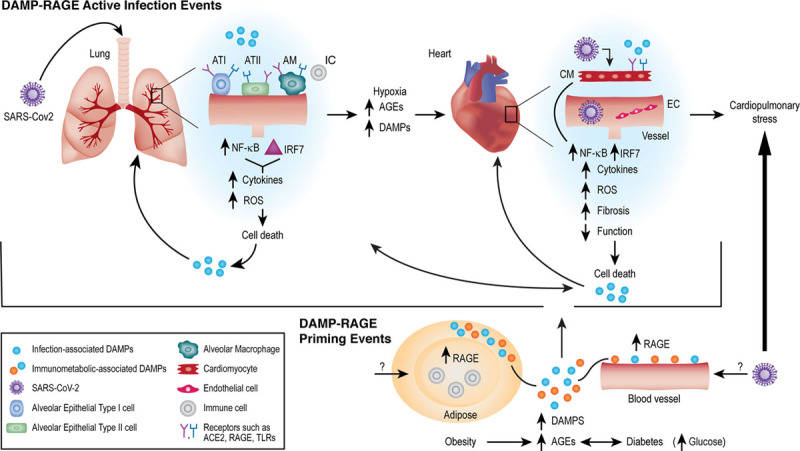Figure.

Receptor for advanced glycation end products (RAGE) and the many roads to severe acute respiratory syndrome coronavirus 2 (SARS-CoV-2). Recent studies from SARS-CoV-2-infected human subjects have demonstrated that elevation of damage-associated molecular patterns (DAMP) ligands of RAGE, such as HMGB1, S100A8, S100A9, S100A11, S100A12, and S100B in the lung tissue, and plasma/serum are associated with disease severity and risk of death. Hence, in active infection, in part I of the hypothesized RAGE response in acute infection (top), these DAMP ligands of RAGE may exacerbate the local responses to infection in organs such as the lung and heart, leading to severe cell stress/death. The known sequelae of RAGE activities, in part through the actions of NF-kB (nuclear factor-kappa B), lead to endothelial dysfunction (permeability, prothrombotic and proinflammatory state); immune cell activation, oxidative stress, and upregulation of distinct factors such as EGR1 (early growth response 1), which coordinates much of the adverse responses to hypoxia and ischemia. The recent observation that RAGE ligands upregulate IRF7 (interferon regulatory factor 7) in immune cells suggests that DAMP RAGE ligands might aggravate disease in SARS-CoV-2 infection. Within the sphere of RAGE biology, many of these same DAMP ligands also accumulate in chronic inflammatory and metabolic disorders. In part 2 of the hypothesized RAGE priming mechanisms in diabetes/hyperglycemia and obesity (bottom), the inexorable accumulation of advanced glycation end products (AGEs) and other DAMP RAGE ligands relevant to cardiometabolic perturbation may prime the organs for amplification of inflammatory and tissue-damaging mechanisms upon SARS-CoV-2 infection. Hence, blockade of RAGE, during immunometabolic priming in diabetes/obesity, or during active SARS-CoV-2 infection, might be efficacious in tempering the damage from acute infection and in preventing diabetes/obesity-mediated amplification of coronavirus disease 2019 (COVID-19) severity. These hypotheses are open questions amenable to investigation. EC indicates endothelial cell; and TLR, toll-like receptor.
